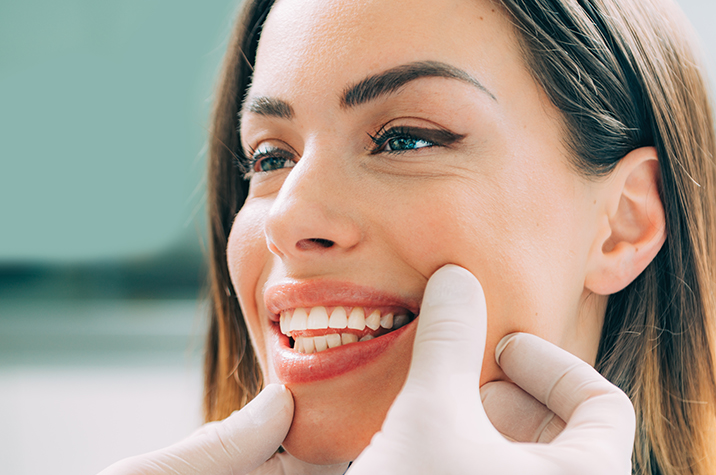How to fix big front teeth? Many of us may have reservations about our teeth, particularly when it comes to their size and appearance. However, it’s crucial to remember that there’s often more to it than meets the eye. When someone perceives their front teeth as overly large, it’s rarely a case of genuinely oversized teeth. Instead, factors such as jaw size can play a significant role in this perception.
In some instances, individuals may have a condition called macrodontia, where their teeth are more than two standard deviations larger. Although it’s relatively rare, affecting approximately 0.03 to 1.9 percent of the global population, macrodontia can make one or two teeth appear unusually large. Sometimes, two teeth grow together, forming a single, extra-large tooth, while in other cases, a single tooth grows abnormally large.
Beyond the dental aspect, people with macrodontia might also experience enlargement of facial features on one side, often related to the pituitary gland’s enlargement. While the exact causes of macrodontia are not entirely clear-cut, factors such as genetics, environmental influences, race, and hormonal imbalances are believed to contribute to its development. Interestingly, men and individuals of Asian descent seem to be at a higher risk of experiencing this condition.
Causes of Macrodontia
Understanding the causes of macrodontia is an intricate puzzle with multiple pieces. Here’s a closer look at the factors believed to influence the development of this condition:
1. Genetics and Genetic Conditions
Genetics plays a significant role in macrodontia. Genetic mutations that regulate tooth growth can lead to teeth growing together or continuing to grow beyond the typical size. These mutations disrupt the natural cessation of tooth growth, resulting in larger-than-normal teeth. Additionally, several genetic conditions are often associated with macrodontia, including insulin-resistant diabetes and more.
2. Childhood Factors
The early years of a person’s life can also contribute to the development of macrodontia. Factors like diet, exposure to toxins or radiation, and other environmental influences during childhood can impact a person’s likelihood of developing this condition.
3. Race and Gender
Studies have shown that certain racial and gender disparities exist in the prevalence of macrodontia. Additionally, males are at a higher risk than females.
4. Hormonal Imbalances
Some genetic conditions linked to macrodontia are associated with hormonal imbalances, particularly those related to the pituitary gland. These imbalances can disrupt normal tooth growth and size regulation.
Treatment Options for Macrodontia: How to Fix Big Front Teeth
Consulting a dentist is the first step if you’re concerned about your enlarged teeth and seek a solution. A dentist can diagnose macrodontia through a dental examination and X-rays. Based on their diagnosis, they will recommend an appropriate treatment plan. Here are some potential treatment options:
1. Orthodontics
Orthodontics can effectively address macrodontia-related concerns by straightening your teeth and expanding your jaw, if necessary. A palate expander, a dental device, can stretch your jaw to create more space for your teeth in your mouth. Additionally, braces and retainers may be used to correct crooked teeth, providing each tooth with more room, which can reduce the appearance of large teeth. In some cases, a dentist may refer you to an orthodontist, a specialist in dental devices and alignment.
2. Teeth Shaving (Tooth Recontouring)
Teeth shaving, also known as tooth recontouring, is a cosmetic option for individuals with macrodontia. During this procedure, a cosmetic dentist uses a gentle sanding device to remove some of the outer layers of your teeth, giving them a smoother appearance. Removing a small amount of tooth material reduces the teeth’s size, making them appear slightly smaller. This technique is particularly effective in reducing the length of canine teeth on the sides of the mouth. It’s generally safe for most individuals, but those with weak teeth should avoid it. X-rays are often taken before the procedure to ensure teeth are suitable for reshaping.
3. Teeth Removal
In some cases, removing certain teeth can help space out the remaining ones, reducing crowding and the appearance of large teeth. Your dentist may recommend visiting an oral surgeon for this procedure. After tooth removal, you can explore options such as false teeth or dentures to enhance your smile’s appearance.
Final Words: How To Fix Big Front Teeth?
In conclusion, if you are concerned about the size of your front teeth, it’s essential to remember that solutions are available to help you regain confidence in your smile. Macrodontia, while rare, can be addressed through various dental treatments and procedures tailored to your specific needs. You can take the first step toward achieving the smile you desire by consulting with a dentist or cosmetic dentist. So, don’t let the size of your teeth hold you back, embrace the possibilities for a brighter, more confident smile.




